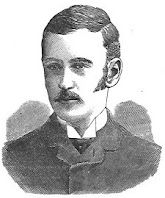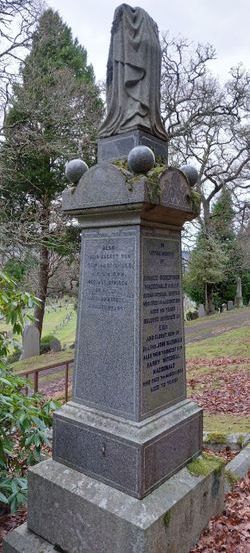Dr. John Macdonald

No known photograph of Dr. John Macdonald seems to exist. Yet he was quietly a major sporting figure, the first to represent Scotland at both cricket and football, and later a medical figure of equally quiet import in the Highlands of his time and beyond, with input even into today's NHS. There is a story too that he was crucial in the career of fellow Invernesian footballer and also later a Scottish international, Peter McWilliam. So it is fortunate we have a sketch from the short time he spent at Queen's Park.
John Macdonald was born on Christmas Eve 1861, the eldest child of Donald, the owner of an Inverness house-painting business, and Harriett Robertson, born in Auldearn by Nairn. They had married in February that same year. John would attend Inverness Academy, where he played cricket and rugby before, aged seventeen, he headed south to Edinburgh to study medicine. There at summer cricket in 1880 he was part of the Scotland team that played the Australian tourists and in 1884 he captained the university. But with regard to his winter game of choice a switch was made from rugby to football, again captaining the university from centre-half, teams in the East of Scotland having adopted, albeit temporarily, the three-man, 2-3-5 half-back line, originated in Wales but by then also widely employed in England.
However, having graduated in 1884 he began to turn out in Glasgow for Queen's Park. There he played eleven times, mainly alongside Charles Campbell on the left of the two-man half-back line employed in the West of Scotland. Those games would include as well as domestic competitions two FA Cup Finals, English FA Cup Finals, in 1884 and 1885, both lost to Blackburn and before Scots teams were from 1885-6 prevented by the SFA from participation. In 1885 he would also represent Glasgow against London and in 1886, once more under the Edinburgh University banner but with Campbell still beside him, he played for Scotland against England, a 1-1 draw at Hampden. It was to be his only cap although there may well have been more had he not decided to return to Inverness to go into medical practice. In 1891 at thirty he was back living with his parents, in 1897 he married a young widow, Isabella "Ella" Mackintosh, with whom he was to have five children. He would also from private practice rise to become Chief Medical Officer for Health for both Inverness Burgh and Inverness County Council.
At home in Inverness, whilst in his leisure time he was still playing cricket, he nevertheless retained an interest in and influence on football. In 1932 he became a patron of the Highland League. And the McWilliam story is that some thirty-five years earlier Peter had been banned by his father from playing but continued to do so under an assumed name. His father had found out and confiscated the young man's boots until a personal visit from the famed doctor changed the old man's mind. It was a visit that might be said to have changed the shape of World football.

Courtesy of Mark Donnelly
And professionally John Macdonald was to have an impact far wider than in just the Highland capital. In 1910 the Dewar Report was commissioned with the intention of looking at providing reliable and affordable health-care for Highland communities, particularly the most remote. It was completed in 1912 and as a result a system of financial subsidy for doctors and payment for nursing-care and hospitals was put in place called the Highlands and Islands Medical Service. John MacDonald, who as MOH would be intimately involved in its launch in 1913 and wrote at the time, something which is still quoted.
"These recommendations, when given effect to, will open up a new era for the improvement of the medical and nursing services in the Highlands and Islands of Scotland."
The words themselves are hardly radical. Indeed, they are a major under-statement, probably politically deliberate one, but with a resonance today that even he would and could not have understood. That is because the HIMC became one of the major models for the National Health Service on its foundation in 1948.
However, that was a development of his professional calling that John Macdonald never saw, although his wife did and must have been a beneficiary. He would in 1938 at the age of seventy-six die in an Edinburgh nursing home, she at the family-home in Inverness in 1962. Both are buried in Inverness's Tomnahurich Cemetery.
Birth Locator:
1861 - 32, Bridge St., Inverness
Residence Locator(s):
1871 - Muirfield Cottage, 26, Old Edinburgh Road, Inverness
1891 - Muirfield Cottage, 26, Old Edinburgh Road, Inverness
1897 - 31, Bridge St., Inverness
1901 - 31, Bridge St., Inverness
1911 - Muirfield Cottage, 26, Old Edinburgh Road, Inverness
1921 - Muirfield Cottage, 26, Old Edinburgh Road, Inverness
Death Locator:
1938 - Marchhall Nursing Home, Edinburgh
Grave Locator:
Tomnahurich Cemetery, Inverness
Back to the Highland and Moray Trail
or the SFHGHome page